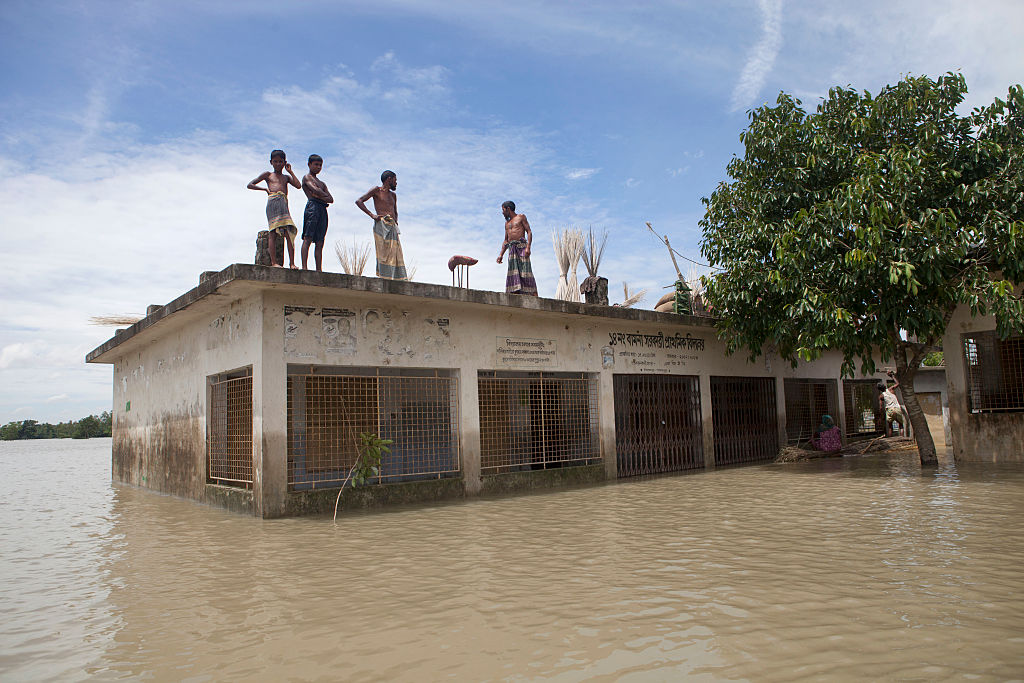
The list of guidelines to allow students to go to school safely is long and complicated: new classroom designs to protect students, flexible school calendars to prepare for the unpredictable and additional teachers standing by in the event that a large number of them become incapacitated, to name just a few.
This agenda could easily be part of a plan to reopen schools in the middle of the COVID-19 pandemic—but it actually comes from a 2010 report on how Bangladesh can adapt its education system to climate change. Just a few years prior, thousands of schools in the country had flooded; dozens washed away entirely. It wouldn’t be the last time. Today, despite precautions, thousands of schools remain closed in Bangladesh as a third of the country is underwater.
Disruption to education of this scale is largely unfamiliar in the U.S., but COVID-19 has given Americans a hint. The particulars of adapting the U.S. educational system vary from place to place, but, in a sense, the unpredictable challenge offers a dry run for how the country’s educational system will be challenged to adapt to climate change and its various effects.
Disruption
The research into the links between climate change and education is in its early stages, but researchers can already identify a long list of potential disruptions.
The most obvious is the ability of climate-related disasters to force schools to shut down for days, weeks or months. This challenge has already harmed learning across the globe, from developing countries like Mozambique where more than 300,000 children had their education disrupted as a result of Cyclone Idai in 2019 to relatively wealthy locales like California and the surrounding area of Sydney, Australia, where wildfires have kept students out of the classroom for extended periods in recent years. And, because schools serve as a civic center in many communities, they are often turned into disaster response centers when they do survive disaster. That’s good for the people in desperate need of shelter, but it doesn’t do much to fulfill a school’s educational mission.
This problem is only compounded for communities that face repeated extreme weather events that create a pattern of disruption. “The linkages between the disruption of education, and climate change are fairly well established,” says Gautam Narasimhan, senior adviser for climate, energy, and environment at UNICEF. “If there’s repeated disruption to education, that makes a child far less likely to go back to school.”
Temperature acts as a key instigator of climate-related education disruption. On a most basic level, warmer temperatures make it harder for students to focus and excel academically, research has shown. This is true in developing countries that lack access to air conditioning and wealthy countries like the U.S. alike. “There’s this comfortable window of temperature that people function well in,” says Heather Randell, a sociologist and demographer at Penn State University who studies climate change and education. “When the temperature exceeds that kids are not doing as well.”Research has also shown that even subtle changes in climate shape educational outcomes. In sub-Saharan Africa and Southeast Asia, two locales prone to drought and extreme temperatures, more rainfall means higher educational attainment. In places prone to storms like the Caribbean, increased rainfall is linked to lower educational achievement, according to research in the journal Proceedings of the National Academy of Sciences.
Beyond the direct threats, climate change poses a much more insidious threat to learning in the developing world. If the family farm floods, for example, a child is much more likely to stay home to help the family earn a living. If a family can’t afford to put food on the table, children will lack proper nutrition and have trouble learning. These problems are worse for girls, who are often the first to be pulled out of school by families in need of extra help. Climate-related migration means consistently disrupting the network of teachers and community where a child learns.
Reopening
It’s hard to apply an educational lesson from the pandemic directly to climate change, in part because the path to reopening schools is so complicated. Facing different on-the-ground coronavirus realities, no two cities are having the exact same conversation.
But it’s clear that climate change may force educators to make similar calculations to those that have come in response to COVID-19. How can classrooms be renovated with resilience in mind? Is it safe to bring kids back to the classroom in the first place, or should they learn remotely? What about students who lack resources at home, whether that’s high-speed internet or air conditioning?
With both challenges, schools will be forced to work their way through these questions. If the COVID-19 pandemic is any hint, the educational system will be woefully unprepared; thinking about these concerns ahead of time can help mitigate that risk.
A version of this article was originally published in TIME’s climate newsletter, One.Five. Click here to sign up to receive these stories early.
More Must-Reads From TIME
- The 100 Most Influential People of 2024
- Coco Gauff Is Playing for Herself Now
- Scenes From Pro-Palestinian Encampments Across U.S. Universities
- 6 Compliments That Land Every Time
- If You're Dating Right Now , You're Brave: Column
- The AI That Could Heal a Divided Internet
- Fallout Is a Brilliant Model for the Future of Video Game Adaptations
- Want Weekly Recs on What to Watch, Read, and More? Sign Up for Worth Your Time
Write to Justin Worland at justin.worland@time.com